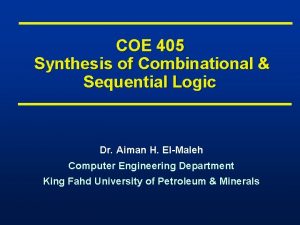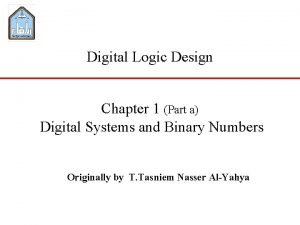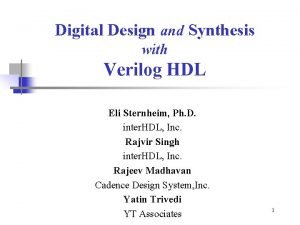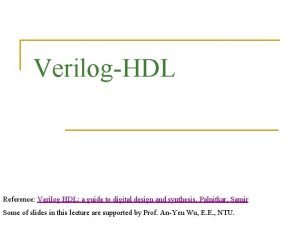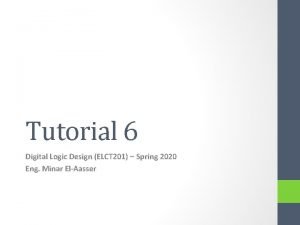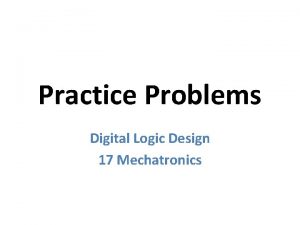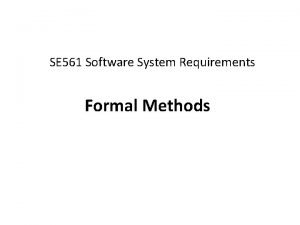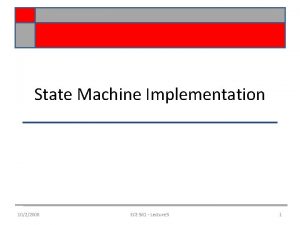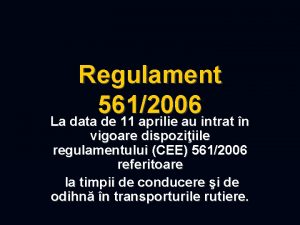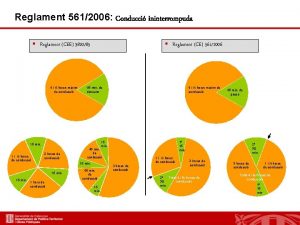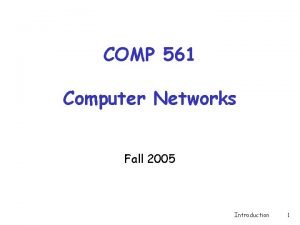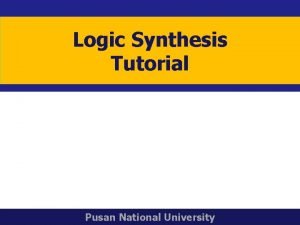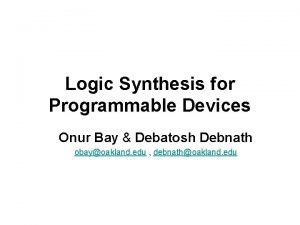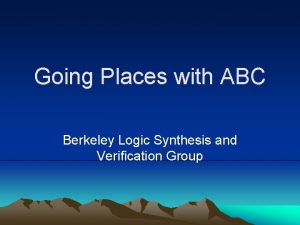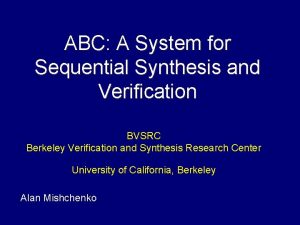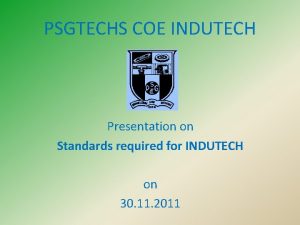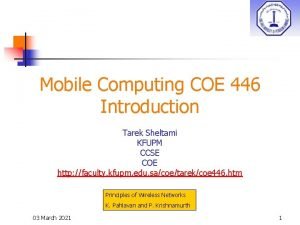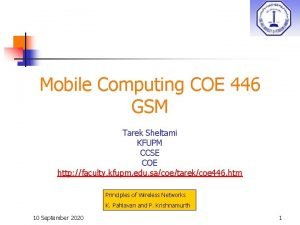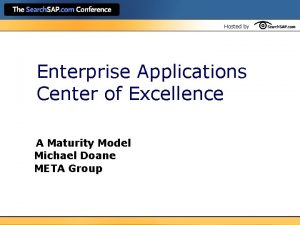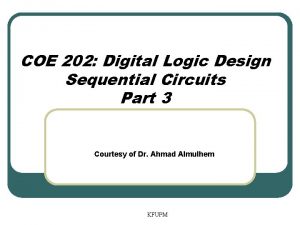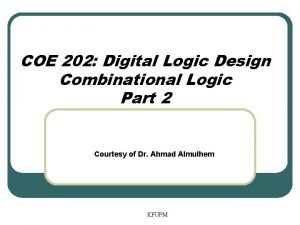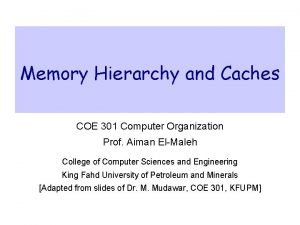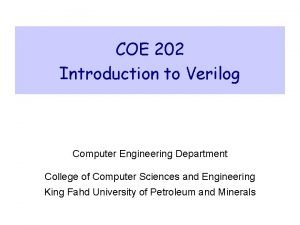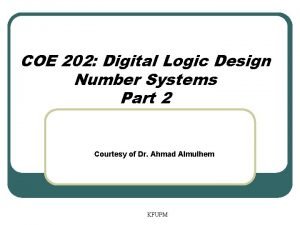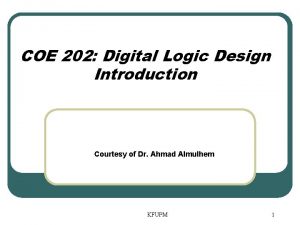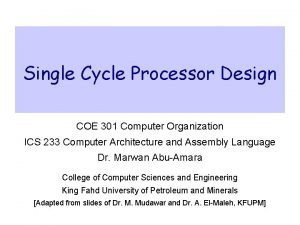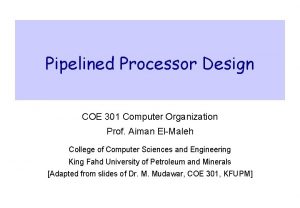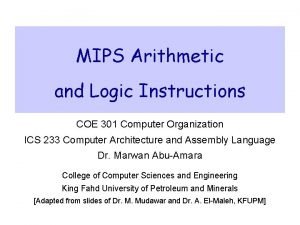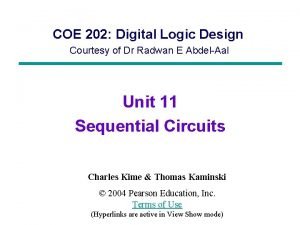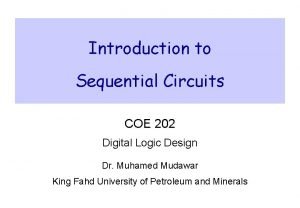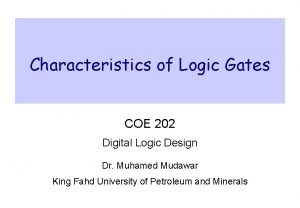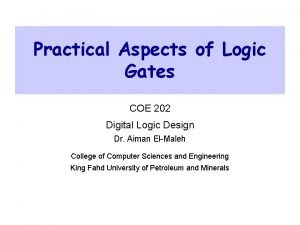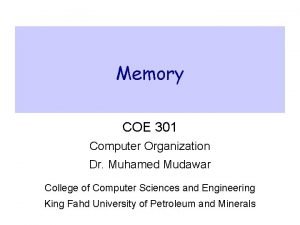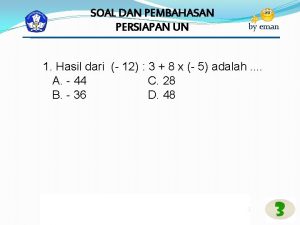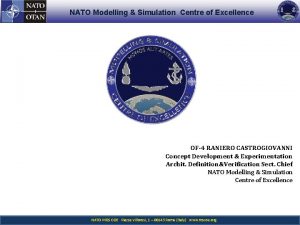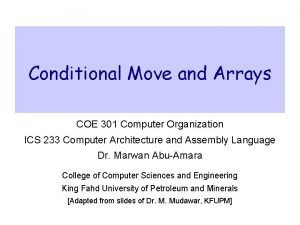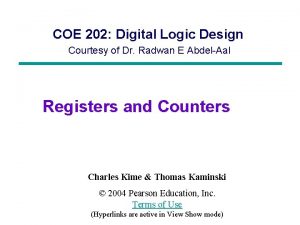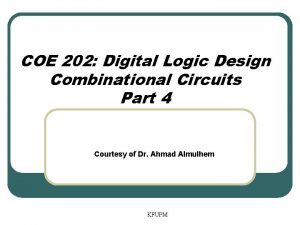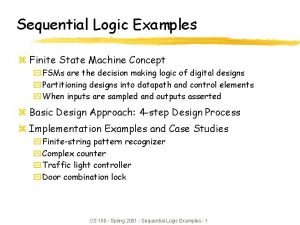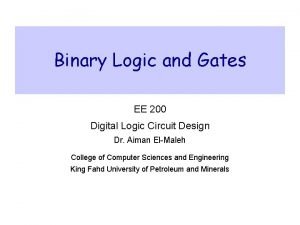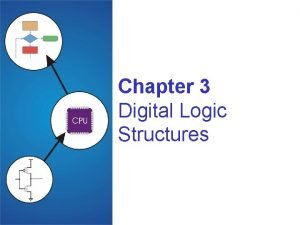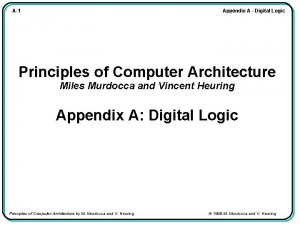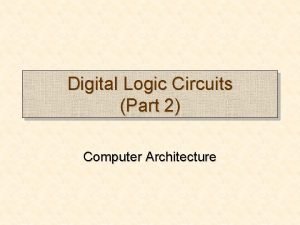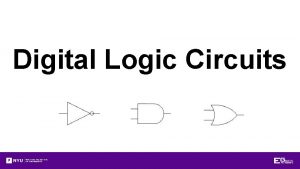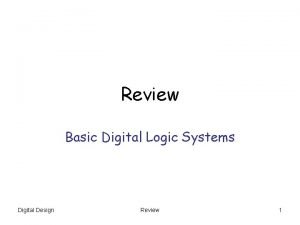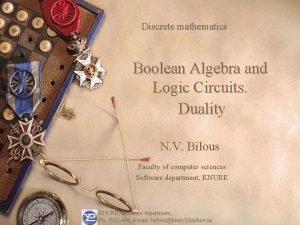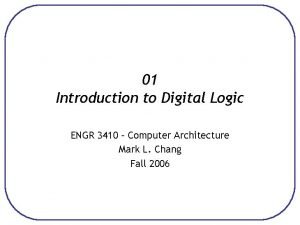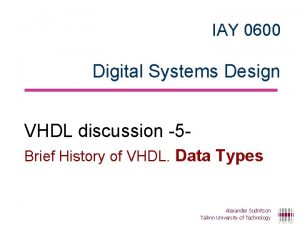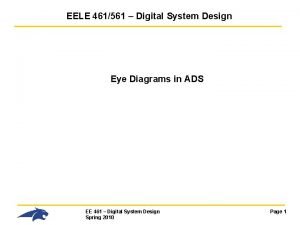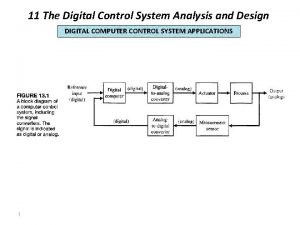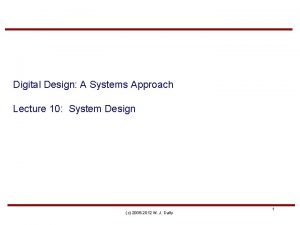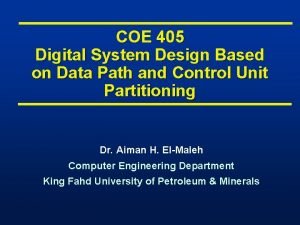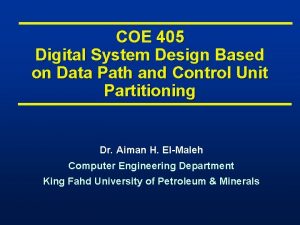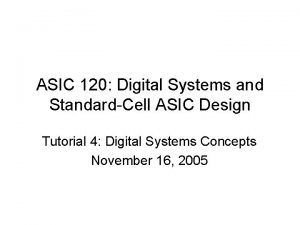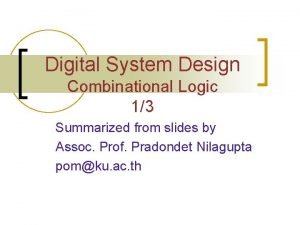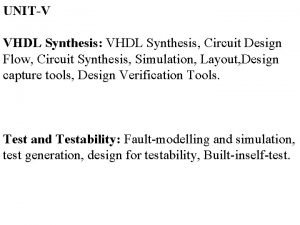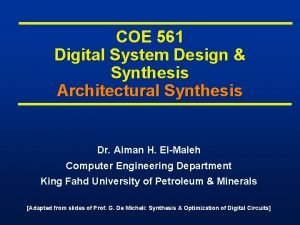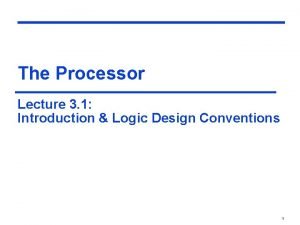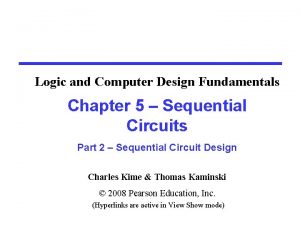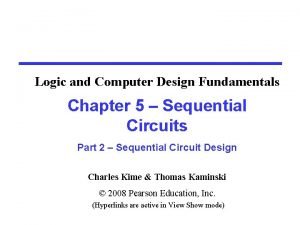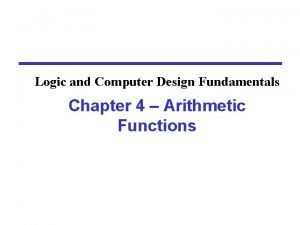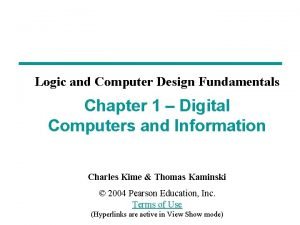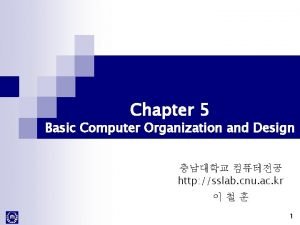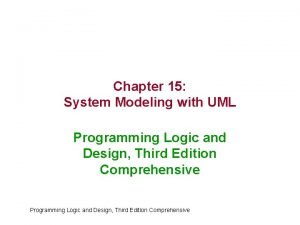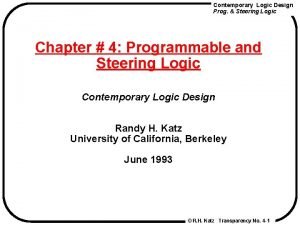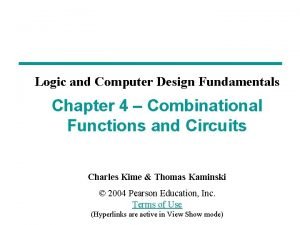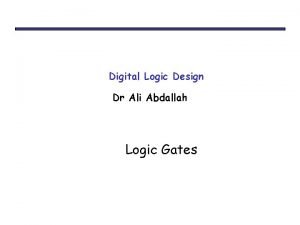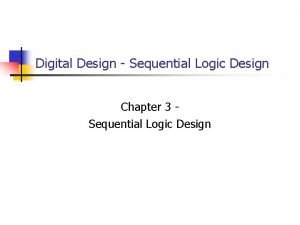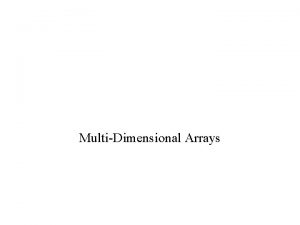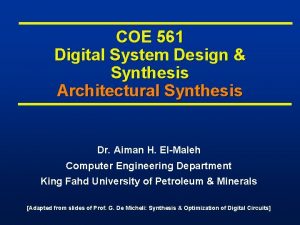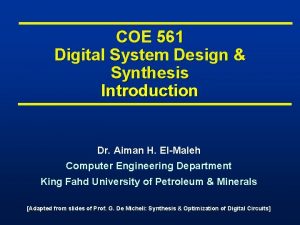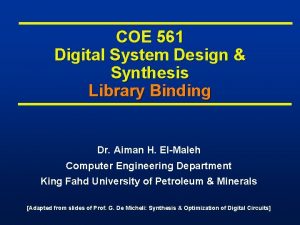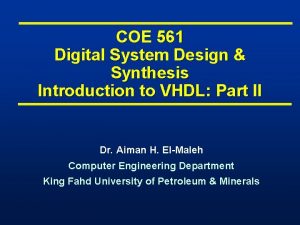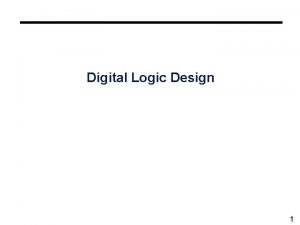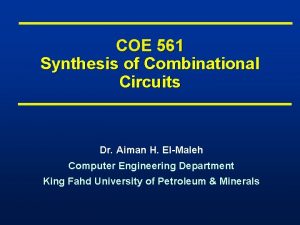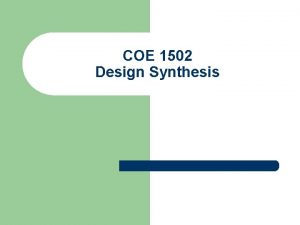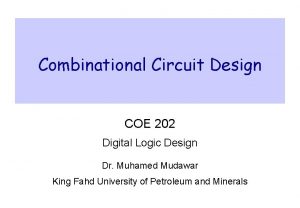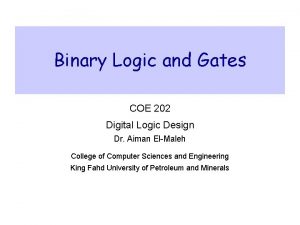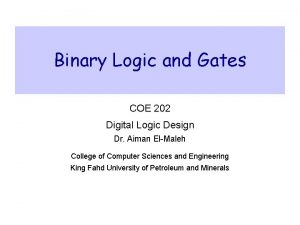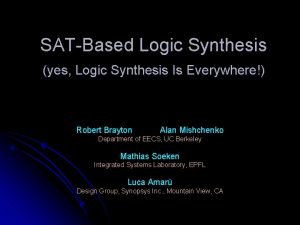COE 561 Digital System Design Synthesis MultipleLevel Logic






















































































































- Slides: 118

COE 561 Digital System Design & Synthesis Multiple-Level Logic Synthesis Dr. Aiman H. El-Maleh Computer Engineering Department King Fahd University of Petroleum & Minerals [Adapted from slides of Prof. G. De Micheli: Synthesis & Optimization of Digital Circuits]

Outline … n n Representations. Taxonomy of optimization methods. • Goals: area/delay. • Algorithms: Algebraic/Boolean. • Rule-based methods. Examples of transformations. Algebraic model. • Algebraic division. • Algebraic substitution. • Single-cube extraction. • Multiple-cube extraction. • Decomposition. • Factorization. • Fast extraction. 2

… Outline n External and internal don’t care sets. n Boolean simplification and substitution. n Testability properties of multiple-level logic. n Synthesis for testability. n Network delay modeling. n Algorithms for delay minimization. n Transformations for delay reduction. • Controllability don’t care sets. • Observability don’t care sets. 3

Motivation n Combinational logic circuits very often implemented as multiple-level networks of logic gates. Provides several degrees of freedom in logic design • Exploited in optimizing area and delay. • Different timing requirements on input/output paths. Multiple-level networks viewed as interconnection of single-output gates • Single type of gate (e. g. NANDs or NORs). • Instances of a cell library. • Macro cells. n Multilevel optimization is divided into two tasks • Optimization neglecting implementation constraints assuming loose models of area and delay. • Constraints on the usable gates are taken into account during optimization. 4

Circuit Modeling n Logic network n Bound (mapped) networks • Interconnection of logic functions. • Hybrid structural/behavioral model. • Interconnection of logic gates. • Structural model. Example of Bound Network 5

Example of a Logic Network 6

Network Optimization n Two-level logic • Area and delay proportional to cover size. • Achieving minimum (or irredundant) covers corresponds to optimizing area and speed. • Achieving irredundant cover corresponds to maximizing testability. n Multiple-level logic • Minimal-area implementations do not correspond in general to minimum-delay implementations and vice versa. • Minimize area (power) estimate • subject to delay constraints. • Minimize maximum delay • subject to area (power) constraints. • Minimize power consumption. • subject to delay constraints. • Maximize testability. 7

Estimation n Area • Number of literals • Corresponds to number of polysilicon strips (transistors) • Number of functions/gates. n Delay • Number of stages (unit delay per stage). • Refined gate delay models (relating delay to function • • complexity and fanout). Sensitizable paths (detection of false paths). Wiring delays estimated using statistical models. 8

Problem Analysis n Multiple-level optimization is hard. n Exact methods n Approximate methods n Strategies for optimization • Exponential complexity. • Impractical. • Heuristic algorithms. • Rule-based methods. • Improve circuit step by step based on circuit transformations. • Preserve network behavior. • Methods differ in • Types of transformations. • Selection and order of transformations. 9

Elimination n Eliminate one function from the network. n Perform variable substitution. n Example • s = r +b’; r = p+a’ • s = p+a’+b’. 10

Decomposition n Break one function into smaller ones. n Introduce new vertices in the network. n Example • v = a’d+bd+c’d+ae’. • j = a’+b+c’; v = jd+ae’ 11

Factoring n Factoring is the process of deriving a factored form from a sum-of-products form of a function. n Factoring is like decomposition except that no additional nodes are created. n Example • F = abc+abd+a’b’c+a’b’d+ab’e+ab’f+a’be+a’bf (24 literals) • After factorization • F=(ab+a’b’)(c+d) + (ab’+a’b)(e+f) (12 literals) 12

Extraction … n Find a common sub-expression of two (or more) expressions. n Extract sub-expression as new function. n Introduce new vertex in the network. n Example • p = ce+de; • p = (c+d)e; • k = c+d; t = ac+ad+bc+bd+e; (13 literals) t = (c+d)(a+b)+e; (Factoring: 8 literals) p = ke; t = ka+ kb +e; (Extraction: 9 literals) 13

… Extraction 14

Simplification n Simplify a local function (using Espresso). n Example • • u = q’c+qc’ +qc; u = q +c; 15

Substitution n Simplify a local function by using an additional input that was not previously in its support set. n Example • • t = ka+kb+e. t = kq +e; because q = a+b. 16

Example: Sequence of Transformations Original Network (33 lit. ) Transformed Network (20 lit. ) 17

Optimization Approaches n Algorithmic approach • Define an algorithm for each transformation type. • Algorithm is an operator on the network. • Each operator has well-defined properties • Heuristic methods still used. • Weak optimality properties. • Sequence of operators • Defined by scripts. • Based on experience. n Rule-based approach (IBM Logic Synthesis System) • Rule-data base • Set of pattern pairs. • Pattern replacement driven by rules. 18

Elimination Algorithm … n Set a threshold k (usually 0). n Examine all expressions (vertices) and compute their values. n Vertex value = n*l – n – l (l is number of literals; n is number of times vertex variable appears in network) n Eliminate an expression (vertex) if its value (i. e. the increase in literals) does not exceed the threshold. 19

… Elimination Algorithm n Example n Value of vertex q=n*l–n–l=3*2 -3 -2=1 n Assume u is simplified to u=c+q • q=a+b • s = ce + de + a’ + b’ • t = ac + ad + bc + bd + e • u = q’c + qc’ + qc • v = a’d + bd + c’d + ae’ • It will increase number of literals => not eliminated • Value of vertex q=n*l–n–l=1*2 -1 -2=-1 • It will decrease the number of literals by 1 => eliminated 20

MIS/SIS Rugged Script n sweep; eliminate -1 n simplify -m nocomp n eliminate -1 n sweep; eliminate 5 n simplify -m nocomp n resub -a n fx n resub -a; sweep n eliminate -1; sweep n full-simplify -m nocomp Sweep eliminates singleinput Vertices and those with a constant function. resub –a performs algebraic substitution of all vertex pairs fx extracts double-cube and single-cube expression. 21

Boolean and Algebraic Methods … n Boolean methods n Algebraic methods • Exploit Boolean properties of logic functions. • Use don't care conditions induced by interconnections. • Complex at times. • View functions as polynomials. • Exploit properties of polynomial algebra. • Simpler, faster but weaker. 22

… Boolean and Algebraic Methods n Boolean substitution • h = a+bcd+e; q = a+cd • h = a+bq +e • Because a+bq+e = a+b(a+cd)+e = a+bcd+e; • Relies on Boolean property b+1=1 n Algebraic substitution • t = ka+kb+e; q=a+b • t = kq +e • Because k(a+b) = ka+kb; holds regardless of any assumption of Boolean algebra. 23

The Algebraic Model … n Represents local Boolean functions by algebraic expressions • Multilinear polynomial (i. e. multi-variable with degree 1) over set of variables with unit coefficients. n Algebraic transformations neglect specific features of Boolean algebra • Only one distributive law applies • a. (b+c) = ab+ac • a + (b. c) (a+b). (a+c) • Symmetric distribution laws. • Complements are not defined • Cannot apply some properties like absorption, idempotence, involution and Demorgan’s, a+a’=1 and a. a’=0 • Don't care sets are not used. 24

… The Algebraic Model n Algebraic expressions obtained by n Algebraic operations restricted to expressions with disjoint support • Modeling functions in sum of products form. • Make them minimal with respect to single-cube containment. • Preserve correspondence of result with sum-of-product forms minimal w. r. t single-cube containment. n Example • (a+b)(c+d)=ac+ad+bc+bd; minimal w. r. t SCC. • (a+b)(a+c)= aa+ac+ab+bc; non-minimal. • (a+b)(a’+c)=aa’+ac+a’b+bc; non-minimal. 25

Algebraic Division … n Given two algebraic expressions fdividend and fdivisor , we say that fdivisor is an Algebraic Divisor of fdividend , fquotient = fdividend/fdivisor when • fdividend = fdivisor. fquotient + fremainder • fdivisor. fquotient 0 • and the support of fdivisor and fquotient is disjoint. n Example • Let fdividend = ac+ad+bc+bd+e and fdivisor = a+b • Then fquotient = c+d fremainder = e • Because (a+b) (c+d)+e = fdividend • and {a, b} {c, d} = • Non-algebraic division • Let fi = a+bc and fj = a+b. • Let fk = a+c. Then, fi = fj. fk = (a+b)(a+c) • but {a, b} {a, c} 26

… Algebraic Division n An algebraic divisor is called a factor when the remainder is void. • a+b is a factor of ac+ad+bc+bd n An expression is said to be cube free when it cannot be factored by a cube. • a+b is cube free • ac+ad+bc+bd is cube free • ac+ad is non-cube free • abc is non-cube free 27

Algebraic Division Algorithm … n Quotient Q and remainder R are sum of cubes (monomials). n Intersection is largest subset of common monomials. 28

… Algebraic Division Algorithm … n Example • fdividend = ac+ad+bc+bd+e; • fdivisor = a+b; • A = {ac, ad, bc, bd, e} and B = {a, b}. • i=1 • CB 1 = a, D = {ac, ad} and D 1 = {c, d}. • Q = {c, d}. • i=2=n • CB 2 = b, D = {bc, bd} and D 2 = {c, d}. • Then Q = {c, d}. • Result • Q = {c, d} and R = {e}. • fquotient = c+d and fremainder = e. 29

… Algebraic Division Algorithm n Example n Theorem: Given algebraic expressions fi and fj, then fi/fj is empty when • Let fdividend = axc+axd+bc+bxd+e; fdivisor = ax+b • i=1, CB 1 = ax, D = {axc, axd} and D 1 = {c, d}; Q={c, d} • i = 2 = n; CB 2 = b, D = {bc, bxd} and D 2 = {c, xd}. • Then Q = {c, d} {c, xd} = {c}. • fquotient = c and fremainder = axd+bxd+e. • fj contains a variable not in fi. • fj contains a cube whose support is not contained in that of • • any cube of fi. fj contains more cubes than fi. The count of any variable in fj larger than in fi. 30

Substitution n Substitution replaces a subexpression by a variable associated with a vertex of the logic network. n Consider expression pairs. n Apply division (in any order). n If quotient is not void n Use filters to reduce divisions. n Theorem • Evaluate area/delay gain • Substitute fdividend by j. fquotient + fremainder where j = fdivisor • Given two algebraic expressions fi and fj, fi/fj= if there is a path from vi to vj in the logic network. 31

Substitution algorithm 32

Extraction n Search for common sub-expressions n Search for appropriate divisors. n Cube-free expression n Kernel of an expression • Single-cube extraction: monomial. • Multiple-cube (kernel) extraction: polynomial • Cannot be factored by a cube. • Cube-free quotient of the expression divided by a cube (called co-kernel). n Kernel set K(f) of an expression • Set of kernels. 33

Kernel Example n fx = ace+bce+de+g n Divide fx by a. Get ce. Not cube free. n Divide fx by b. Get ce. Not cube free. n Divide fx by c. Get ae+be. Not cube free. n Divide fx by ce. Get a+b. Cube free. Kernel! n Divide fx by d. Get e. Not cube free. n Divide fx by e. Get ac+bc+d. Cube free. Kernel! n Divide fx by g. Get 1. Not cube free. n Expression fx is a kernel of itself because cube free. n K(fx) = {(a+b); (ac+bc+d); (ace+bce+de+g)}. 34

Theorem (Brayton and Mc. Mullen) n Two expressions fa and fb have a common multiplecube divisor fd if and only if • there exist kernels ka K(fa) and kb K(fb) s. t. fd is the sum of 2 (or more) cubes in ka kb (intersection is largest subset of common monomials) n Consequence • If kernel intersection is void, then the search for common subexpression can be dropped. n Example fx = ace+bce+de+g; fy = ad+bd+cde+ge; fz = abc; K(fx) = {(a+b); (ac+bc+d); (ace+bce+de+g)} K(fy) = {(a+b+ce); (cd+g); (ad+bd+cde+ge)} The kernel set of fz is empty. Select intersection (a+b) fw = a+b fx = wce+de+g fy = wd+cde+ge fz = abc 35

Kernel Set Computation … n Naive method n Smart way • Divide function by elements in power set of its support set. • Weed out non cube-free quotients. • Use recursion • Kernels of kernels are kernels of original expression. • Exploit commutativity of multiplication. • Kernels with co-kernels ab and ba are the same n A kernel has level 0 if it has no kernel except itself. n A kernel is of level n if it has • at least one kernel of level n-1 • no kernels of level n or greater except itself 36

…Kernel Set Computation n Y= adf + aef + bdf + bef + cdf + cef + g = (a+b+c)(d+e) f + g Kernels Co-Kernels Level (a+b+c) df, ef 0 (d+e) (a+b+c)(d+e) af, bf, cf f 0 1 (a+b+c)(d+e)f+g 1 2 37

Recursive Kernel Computation: Simple Algorithm • f is assumed to be cube-free • If not divide it by its largest cube factor 38

Recursive Kernel Computation Example n f = ace+bce+de+g n Literals a or b. No action required. n Literal c. Select cube ce: • Recursive call with argument (ace+bce+de+g)/ce =a+b; • No additional kernels. • Adds a+b to the kernel set at the last step. n Literal d. No action required. n Literal e. Select cube e: • Recursive call with argument ac+bc+d • Kernel a+b is rediscovered and added. • Adds ac + bc + d to the kernel set at the last step. n Literal g. No action required. n Adds ace+bce+de+g to the kernel set. n K = {(ace+bce+de+g); (a+b); (ac+bc+d); (a+b)}. 39

Analysis n Some computation may be redundant • Example • Divide by a and then by b. • Divide by b and then by a. • Obtain duplicate kernels. n Improvement • Keep a pointer to literals used so far denoted by j. • J initially set to 1. • Avoids generation of co-kernels already calculated • Sup(f)={x 1, x 2, …xn} (arranged in lexicographic order) • f is assumed to be cube-free • If not divide it by its largest cube factor • Faster algorithm 40

Recursive Kernel Computation 41

Recursive Kernel Computation Examples… n n n f = ace+bce+de+g; sup(f)={a, b, c, d, e, g} Literals a or b. No action required. Literal c. Select cube ce: • Recursive call with arguments: (ace+bce+de+g)/ce =a+b; pointer j = 3+1=4. • Call considers variables {d, e, g}. No kernel. • Adds a+b to the kernel set at the last step. Literal d. No action required. Literal e. Select cube e: • Recursive call with arguments: ac+bc+d and pointer j = 5+1=6. • Call considers variable {g}. No kernel. • Adds ac+bc+d to the kernel set at the last step. n n n Literal g. No action required. Adds ace+bce+de+g to the kernel set. K = {(ace+bce+de+g); (ac+bc+d); (a+b)}. 42

…Recursive Kernel Computation Examples n Y= adf + aef + bdf + bef + cdf + cef + g=(d+e)(a+b+c)f+g • Lexicographic order {a, b, c, d, e, f, g} adf + aef + bdf + bef + cdf + cef + g af df bf cf d+e ef a+b+c d+e ad+ae+bd+be+cd+ce 43

Matrix Representation of Kernels … n Boolean matrix • Rows: cubes. Columns: variables (in both true and complement form as needed). n Rectangle (R, C) n Prime rectangle n Co-rectangle (R, C’) of a rectangle (R, C) n A co-kernel corresponds to a prime rectangle with at least two rows & a kernel corresponds to its corectangle. • Subset of rows and columns with all entries equal to 1. • Rectangle not inside any other rectangle. • C’ are the columns not in C. 44

… Matrix Representation of Kernels … n fx = ace+bce+de+g n Rectangle (prime): ({1, 2}, {3, 5}) n • Co-kernel ce. Co-rectangle: ({1, 2}, {1, 2, 4, 6}). • Kernel a+b. 45

… Matrix Representation of Kernels … n Theorem: K is a kernel of f iff it is an expression corresponding to the co-rectangle of a prime rectangle of f. n The set of all kernels of a logic expression are in 1 -1 correspondence with the set of all co-rectangles of prime rectangles of the corresponding Boolean matrix. n A level-0 kernel is the co-rectangle of a prime rectangle of maximal width. n A prime rectangle of maximum height corresponds to a kernel of maximal level. 46

… Matrix Representation of Kernels n Example • F = abc + abd + ae 1 2 3 1 Cube a abc 1 abd 1 ae 1 2 b 1 1 3 c 1 4 d 5 e 1 1 • Prime Rectangles & Co-Rectangles • • PR: {(1, 2), (1, 2)}: corresponding to co-kernel ab CR: {(1, 2), (3, 4, 5)}: corresponding to kernel (c+d) PR: {(1, 2, 3), (1)}: corresponding to co-kernel a CR: {(1, 2, 3), (2, 3, 4, 5)}: corresponding to kernel (bc+bd+e) 47

Single-Cube Extraction … n n n Form auxiliary function • Sum of all product terms of all functions. Form matrix representation • • • A rectangle with at least two rows represents a common cube. Rectangles with at least two columns may result in savings. Best choice is a prime rectangle. Use function ID for cubes • Cube intersection from different functions. 48

… Single-Cube Extraction n n Expressions • • fx = ace+bce+de+g fs = cde+b Auxiliary function • faux = ace+bce+de+g + cde+b n Matrix: n Prime rectangle: ({1, 2, 5}, {3, 5}) n Extract cube ce. 49

Single-Cube Extraction Algorithm Extraction of an l-variable cube with multiplicity n saves (n l – n – l) literals 50

Multiple-Cube Extraction … n We need a kernel/cube matrix. n Relabeling n n • • Cubes by new variables. Kernels by cubes. Form auxiliary function • Sum of all kernels. Extend cube intersection algorithm. 51

… Multiple-Cube Extraction n n n fp = ace+bce. • K(fp) = {(a+b)}. fq = ae+be+d. • K(fq) = {(a+b), (ae +be+d)}. fr = ae+be+de. • K(fr) = {(a+b+d)}. Relabeling • xa = a; xb = b; xae = ae; xbe = be; xd = d; • K(fp) = {(xa, xb)} Cube • K(fq) = {(xa, xb); (xae, xbe, xd)}. xa xb • K(fr) = {(xa, xb, xd)}. xa xb xaexbexd faux = xaxb +xaexbexd + xaxbxd. X a xbxd Common cube: xaxb. • xaxb corresponds to kernel intersection a+b. • Extract a+b from fp, fq and fr. xa xb xae xbe xd 1 1 1 1 1 52

Kernel Extraction Algorithm … N indicates the rate at which kernels are recomputed K indicates the maximum level of the kernel computed 53

… Kernel Extraction Algorithm n Example • F 1= ac+bc; • F 2= ad+bd+cd; • F 3= ab+ac; Cube x ax b x c xb xc xa 1 1 Kernels: {(a+b)} Kernels: {(a+b+c)} Kernels: {(b+c)} xb 1 1 1 xc 1 1 After extracting kernel (a+b), kernel (b+c) is no longer a common kernel. This is why kernel intersections need to be recomputed. 54

Tradeoffs in Kernel Extraction 55

Area Value of a Kernel … n Let n be the number of times a kernel is used n Let l be the number of literals in a kernel and c be the number of cubes in a kernel n Let CKi be the co-kernel for kernel i n Initial cost = i=1 to n (|CKi|*c+l)=nl + c * i=1 to n |CKi| n Resulting cost = l+ i=1 to n (|CKi|+1) = n+l+ i=1 to n |CKi| n Value of a kernel = initial cost – resulting cost = {nl + c * i=1 to n |CKi|} – {n+l+ i=1 to n |CKi|} = nl – n – l + (c-1) * i=1 to n |CKi| 56

… Area Value of a Kernel n Example: n After Kernel extraction: n Value of kernel = nl – n –l + (c-1) * i=1 to n |CKi| • X = acd + bcd = (a+b)cd (6 literals) • Y = adef + bdef = (a+b)def (8 lietrals) • Initial cost = 14 literals • Z=a+b (2 literals) • X=Zcd (3 literals) • Y=Zdef (4 lietrals) • Resulting cost = 9 literals • Savings = 14 – 9 = 5 literals • =2*2 -2 -2+(2 -1)*(2+3)=5 literals 57

Issues in Common Cube and Multiple-Cube Extraction n Greedy approach can be applied in common cube and multiple-cube extraction • Rectangle selection • Matrix update n Greedy approach may be myopic n Non-prime rectangles can contribute to lower cost covers than prime rectangles • Local gain of one extraction considered at a time • Quine’s theorem cannot be applied to rectangles 58

Decomposition … n Goals of decomposition • • Reduce the size of expressions to that typical of library cells. Small-sized expressions more likely to be divisors of other expressions. n Different decomposition techniques exist. n Algebraic-division-based decomposition n • • Give an expression f with fdivisor as one of its divisors. Associate a new variable, say t, with the divisor. Reduce original expression to f= t. fquotient + fremainder and t= fdivisor. Apply decomposition recursively to the divisor, quotient and remainder. Important issue is choice of divisor • • • A kernel. A level-0 kernel. Evaluate all kernels and select most promising one. 59

… Decomposition n fx = ace+bce+de+g n Select kernel ac+bc+d. n Decompose: fx = te+g; ft = ac+bc+d; n Recur on the divisor ft • • Select kernel a+b Decompose: ft = sc+d; fs = a+b; 60

Decomposition Algorithm K is a threshold that determines the size of nodes to be decomposed. 61

Factorization Algorithm n FACTOR(f) If (the number of literals in f is one) return f K =choose_Divisor(f) (h, r) = Divide(f, k) Return (FACTOR(k) FACTOR(h) + FACTOR(r)) n Quick factoring: divisor restricted to first level-0 kernel found • Fast and effective • Used for area and delay estimation n Good factoring: best kernel divisor is chosen n Example: f = ab + ac + bd + ce + cg • Quick factoring: f = a (b+c) + c (e+g) + bd • Good factoring: f = c (a+e+g) + b(a+d) (8 literals) (7 literals) 62

One-Level-0 -Kernel(f) If (|f| ≤ 1) return 0 If (L = Literal_Count(f) ≤ 1) return f For (i=1; i ≤n; i++){ If (L(i) > 1){ C= largest cube containing i s. t. CUBES(f, C)=CUBES(f, i) return One-Level-0 -Kernel(f/f. C) } } n Literal_Count returns a vector of literal counts for each literal. • If all counts are ≤ 1 then f is a level-0 kernel n The first literal with a count greater than one is chosen. 63

Fast Extraction (FX) … n Very efficient extraction method • Based on extraction of double-cube divisors along with their • • complements and, Single-cube divisors with two literals. Number of divisors in polynomial domain. Preserves single stuck-at fault testability. [Rajski and Vasudevamurthy 1992]. n Double-cube divisors are cube-free multiple-cube divisors having exactly two cubes. n The set of double-cube divisors of a function f, denoted D(f) = {d | d= {ci (ci cj), cj (ci cj) } } for i, j=1, . . n, i≠j • n is number of cubes in f. • (ci cj) is called the base of a double-cube divisor. • Empty base is allowed. 64

… Fast Extraction (FX) … n Example: f = ade + ag + bcde +bcg. n Double-cube divisors and their bases: n n Double-cube divisors de+g Base a, bc a+bc ade+bcg ag+bcde g, de {} {} A subset of double-cube divisors is represented by Dx, y, s • • • x is number of literals in first cube y is number of literals in second cube s is number of variables in support of D A subset of single-cube divisors is denoted by Sk where k is number of literals in single-cube divisor. 65

Properties of Double-Cube and Single. Cube Divisors n Example: n D 1, 1, 1 and D 1, 2, 2 are null set. n For any d D 1, 1, 2 , d’ S 2. n For any d D 1, 2, 3 , d’ D. n For any d D 2, 2, 2 , d is either XOR or XNOR and d’ D 2, 2, 2. n For any d D 2, 2, 3 , d’ D 2, 2, 3. n For any d D 2, 2, 4 , d’ D. • xy+y’zp D 2, 3, 4 • ab S 2 66

Extraction of Double-cube Divisor along with its Complement n Theorem: Let f and g be two expressions. Then, f has neither a complement double-cube divisor nor a complement single-cube divisor in g if • di ≠ sj’ for every di D 1, 1, 2 (f) , sj S 2(g) • di ≠ sj’ for every di D 1, 1, 2 (g) , sj S 2(f) • di ≠ dj’ for every di Dxor (f) , dj Dxnor (g) • di ≠ dj’ for every di Dxnor (f) , dj Dxor (g) • di ≠ dj’ for every di D 2, 2, 3 (f) , dj D 2, 2, 3 (g) 67

Weights of Double-cube Divisors and Single-Cube Divisors n Divisor weight represents literal savings. n Weight of a double-cube divisor d Dx, y, s is w(d) = (p-1)(x+y) – p + i=1 to p |bi| + C • p is the number of times double-cube divisor is used • Includes complements that are also double-cube divisors • |bi| is the number of literals in base of double-cube divisor • C is the number of cubes containing both a and b in case • • n cube ab is a complement of d D 1, 1, 2 (p-1)(x+y) accounts for the number of literals saved by implementing d of size (x+y) once -p accounts for number of literals needed to connect d in its p occurrences Weight of a single-cube divisor c S 2 is k – 2 • K is the number of cubes containing c. 68

Fast Extraction Algorithm Generate double-cube divisors with weights Repeat Select a double-cube divisor d that has a maximum weight Wdmax Select a single-cube divisor s having a maximum weight Wsmax If Wdmax > Wsmax select d else select s W = max(Wdmax, Wsmax) If W > 0 then substitute selected divisor Recompute weights of affected double-cube divisors Until (W<=0) 69

Fast Extraction Example n F = abc + a’b’c + ab’d + a’bd + acd + a’b’d’ (18 literals) d Base Weight ab+a’b’ c 4 bc+b’d a 0 ac+a’d b 0 b+d ac 2 abc+a’b’d’ {} -1 a’c+ad b’ 0 b’c+bd a’ 0 a’b’+ad c 0 c+d’ a’b’ 1 ab’+a’b d 4 b’+c ad 1 ad+a’d’ b’ 0 a’b+ac d 0 bd+b’d’ a’ 0 acd+a’b’d’ {} -1 Single-cube divisors with Wsmax are either ac or a’b’ or ad with weight of 0 Double-cube divisor=ab + a’b’ is selected [1]=ab + a’b’ F= [1]c + [1]’d + acd + a’b’d’ (14 literals) 70

Boolean Methods n Exploit Boolean properties. n Minimization of the local functions. n Slower algorithms, better quality results. n Don’t care conditions related to embedding of a function in an environment • Don't care conditions. • Called external don’t care conditions n External don’t care conditions • Controllability • Observability 71

External Don't Care Conditions … n Controllability don't care set CDCin • Input patterns never produced by the environment at the network's input. n Observability don't care set ODCout • Input patterns representing conditions when an output is not • • observed by the environment. Relative to each output. Vector notation used: ODCout. 72

… External Don't Care Conditions n Inputs driven by a decoder. n CDCin = x 1’x 2’x 3’x 4’+x 1 x 2+x 1 x 3+x 1 x 4+x 2 x 3+x 2 x 4+x 3 x 4. n Outputs observed when x 1+x 4=1. 73

Internal Don't Care Conditions … n Induced by the network structure. n Controllability don't care conditions n Observability don't care conditions • Patterns never produced at the inputs of a subnetwork. • Patterns such that the outputs of a subnetwork are not observed. 74

… Internal Don't Care Conditions n Example: x = a’+b; y= abx + a’cx n CDC of vy includes ab’x+a’x’. n • ab’ x=0; ab’x is a don’t care condition • a’ x=1; a’x’ is a don’t care condition Minimize fy to obtain: fy = ax+a’c. 75

Satisfiability Don't Care Conditions n Invariant of the network • x = f x x ≠ fx SDC. n Useful to compute controllability don't cares. n Example • Assume x = a’ + b • Since x ≠ (a’ + b) is not possible, x (a’ + b)=x’a’ + x’b + xab’ is a don’t care condition. 76

CDC Computation … n Network traversal algorithm n Initial CDC is CDCin. n Move cut forward. n Consensus of a function f with respect to variable x is fx. fx’ • Consider different cuts moving from input to output. • Consider SDC contributions of predecessors. • Remove unneeded variables by consensus. 77

… CDC Computation … 78

… CDC Computation … n Assume CDCin = x 1’x 4’. n Select vertex va • Contribution to CDCcut: a (x 2 x 3). • CDCcut = x 1’x 4’ + a (x 2 x 3). • Drop variables D = {x 2, x 3} • CDCcut = x 1’x 4’. n Select vertex vb • Contribution to CDCcut : b (x 1 +a). • CDCcut = x 1’x 4’ + b (x 1 +a). • Drop variable D = {x 1} • CDCcut = b’x 4’ +b’a. 79

… CDC Computation n Select vertex vc • Contribution to CDCcut: c (x 4 + a). • CDCcut = b’x 4’ +b’a + c (x 4 + a). • Drop variables D = {a, x 4} • CDCcut = b’c’. n Select vertex vd n Select vertex ve • Contribution to CDCcut: d (bc). • CDCcut = b’c’ + d (bc). • Contribution to CDCcut: e (b + c). • CDCcut = b’c’ + d (bc) + e (b + c). • Drop variables D = {b, c} • CDCcut = e’. n CDCcut = e’ = z 2’. 80

Network Perturbation n n n Modify network by adding an extra input . Extra input can flip polarity of a signal x. Replace local function fx by fx . Perturbed terminal behavior: fx( ). A variable is observable if a change in its polarity is perceived at an output. Observability don’t-care set ODC for variable x is (fx(0) fx(1))’ • fx(0)=abc • fx(1)=a’bc • ODCx= (abc a’bc)’ = b’+c’ • Minimizing fx=ab with ODCx= b’+c’ leads to fx=a. 81

Observability Don't Care Conditions n Conditions under which a change in polarity of a signal x is not perceived at the outputs. n Complement of the Boolean Difference n Equivalence of perturbed function: (fx(0) fx(1))’. n Observability don't care computation • f/ x = f|x=1 f|x=0 • Problem • Outputs are not expressed as function of all variables. • If network is flattened to obtain f, it may explode in size. • Requirement • Local rules for ODC computation. • Network traversal. 82

Observability Don't Care Computation … n Assume single-output network with tree structure. n Traverse network tree. n At root n n • ODCout is given. At internal vertices assuming y is the output of x • ODCx = ( fy/ x)’ + ODCy = (fy|x=1 fy|x=0 )’+ ODCy Example • • • Assume ODCout = ODCe = 0. ODCb = ( fe/ b)’ = ((b+c)|b=1 (b+c)|b=0)’= c. ODCc = ( fe/ c)’ = b. ODCx 1 = ODCb + ( fb/ x 1)’ = c+a 1. … 83

… Observability Don't Care Computation n General networks have fanout re-convergence. n For each vertex with two (or more) fanout stems • The contribution of the ODC along the stems cannot be added. • Wrong assumption is intersecting them • • ODCa, b=x 1+c=x 1+a+x 4 ODCa, c=x 4+b=x 4+a+x 1 ODCa, b ODCa, c=x 1+a+x 4 Variable a is not redundant • Interplay of different paths. n More elaborate analysis. 84

Two-way Fanout Stem … n Compute ODC sets associated with edges. n Combine ODCs at vertex. n Formula derivation • Assume two equal perturbations on the edges. 85

… Two-way Fanout Stem n ODCa, b = x 1+c = x 1+a 2+x 4 n ODCa, c = x 4+b = x 4+a 1+x 1 n ODCa = (ODCa, b |a 2=a’ ODCa, c)’ = ((x 1+a’+x 4) (x 4+a+x 1))’ = x 1+x 4 a 1 a 2 86

Multi-Way Stems Theorem n Let vx V be any internal or input vertex. n Let {xi; i = 1, 2, … , p} be the edge variables corresponding to {(x, yi) ; i = 1, 2, … , p}. n n Let ODCx, yi ; i = 1, 2, … , p be the edge ODCs. For a 3 -fanout stem variable x: ODCx = ODCx, y 1 |x 2=x 3=x’ ODCx, y 2 |x 3=x’ ODCx, y 3 87

Observability Don't Care Algorithm … n For each variable, intersection of ODC at all outputs yields condition under which output is not observed • Global ODC of a variable n The global ODC conditions of the input variables is the input observability don’t care set ODCin. • May be used as external ODC sets for optimizing a network feeding the one under consideration 88

… Observability Don't Care Algorithm Global ODC of a is (x 1 x 4)(x 1+x 4)=x 1 x 4 89

Transformations with Don't Cares n Boolean simplification n Boolean substitution n Example • Use standard minimizer (Espresso). • Minimize the number of literals. • Simplify a function by adding an extra input. • Equivalent to simplification with global don't care conditions. • Substitute q = a+cd into fh = a+bcd+e to get fh = a+bq +e. • SDC set: q (a+cd) = q’a+q’cd+qa’(cd)’. • Simplify fh = a+bcd+e with q’a+q’cd+qa’(cd)’ as don't care. • Simplication yields fh = a+bq +e. • One literal less by changing the support of fh. 90

Single-Vertex Optimization 91

Optimization and Perturbations … n Replace fx by gx. n Perturbation x = fx gx. n Condition for feasible replacement • • • Perturbation bounded by local don't care set x DCext + ODCx If fx and gx have the same support set S(x) then • If S(gx) includes network variables • x DCext +ODCx + CDCS(x) • x DCext +ODCx + SDCx 92

… Optimization and Perturbations n No external don't care set. n Replace AND by wire: gx = a n Analysis • x = fx gx = ab a = ab’. • ODCx = y’ = b’ +c’. • x = ab’ DCx = b’ +c’ feasible! 93

Synthesis and Testability n Assumptions n Full testability n Synergy between synthesis and testing. n Testable networks correlate to small-area networks. n Don't care conditions play a major role. • Ease of testing a circuit. • Combinational circuit. • Single or multiple stuck-at faults. • Possible to generate test set for all faults. 94

Test for Stuck-at-Faults n Net y stuck-at 0 • Input pattern that sets y to true. • Observe output. • Output of faulty circuit differs. • {t | y(t). ODC’y(t) = 1}. n Net y stuck-at 1 n Need controllability and observability. • Same, but set y to false. • {t | y’(t). ODC’y(t) = 1}. 95

Using Testing Methods for Synthesis … n Redundancy removal. • Use ATPG to search for untestable faults. n If stuck-at 0 on net y is untestable n If stuck-at 1 on y is untestable • Set y = 0. • Propagate constant. • Set y = 1. • Propagate constant. 96

… Using Testing Methods for Synthesis 97

Redundancy Removal and Perturbation Analysis n Stuck-at 0 on y. • y set to 0. Namely gx = fx|y=0. • Perturbation • = fx fx|y=0 = y. fx / y. n Perturbation is feasible fault is untestable. n = y. fx / y DCx fault is untestable n Making fx prime and irredundant with respect to DCx guarantees that all single stuck-at faults in fx are testable. 98

Synthesis for Testability n Synthesize networks that are fully testable. n Two-level forms • Single stuck-at faults. • Multiple stuck-at faults. • Full testability for single stuck-at faults • Prime and irredundant cover. • Full testability for multiple stuck-at faults • Prime and irredundant cover when • Single-output function. • No product term sharing in case of multiple outputs i. e. each output is prime and irredundant. 99

… Synthesis for Testability n A complete single-stuck-at fault test set for a singleoutput sum-of-product circuit is a complete test set for all multiple stuck-at faults. n Single stuck-at fault testability of multiple-level network does not imply multiple stuck-at fault testability. n Fast extraction transformations are single stuck-at fault test-set preserving transformations. n Algebraic transformations preserve multiple stuck-at fault testability but not single stuck-at fault testability • Factorization • Substitution (without complement) • Cube and kernel extraction 100

Synthesis of Testable Multiple-Level Networks … n A logic network Gn(V, E), with local functions in sum of product form. n Prime and irredundant (PI) n Simultaneously prime and irredundant (SPI) n A logic network is PI if and only if n • No literal nor implicant of any local function can be dropped. • No subset of literals and/or implicants can be dropped. • its AND-OR implementation is fully testable for single stuck-at faults. A logic network is SPI if and only if • its AND-OR implementation is fully testable for multiple stuckat faults. 101

… Synthesis of Testable Multiple-Level Networks n Compute full local don't care sets. n Pitfall n Solution n Flatten to two-level form. n Make SPI by disjoint logic minimization. n Reconstruct multiple-level network • Make all local functions PI w. r. to don't care sets. • Don't cares change as functions change. • Iteration (Espresso-MLD). • If iteration converges, network is fully testable. • When possible -- no size explosion. • Algebraic transformations preserve multifault testability. 102

Timing Issues in Multiple-Level Logic Optimization n Timing optimization is crucial for achieving competitive logic design. n Timing verification: Check that a circuit runs at speed n Algorithms for timing optimization. • Satisfies I/O delay constraints. • Satisfies cycle-time constraints. • Delay modeling. • Critical paths. • The false path problem. • Minimum area subject to delay constraints. • Minimum delay (subject to area constraints). 103

Delay Modeling n Gate delay modeling n Network delay modeling • Straightforward for bound networks. • Approximations for unbound networks. • Compute signal propagation • Topological methods. • Logic/topological methods. n Gate delay modeling for unbound networks • Virtual gates: Logic expressions. • Stage delay model: Unit delay per vertex. • Refined models: Depending on size and fanout. 104

Network Delay Modeling … n For each vertex vi. n Data-ready time ti. n The maximum data-ready time occurring at an output vertex • Propagation delay di. • Denotes the time at which the data is ready at the output. • Input data-ready times denote when inputs are available. • Computed elsewhere by forward traversal • Corresponds to the longest propagation delay path • Called topological critical path 105

… Network Delay Modeling … tg= 3+0=3 th= 8+3=11 tk= 10+3=13 tn= 5+10=15 tp= 2+max{15, 3}=17 tl= 3+max{13, 17}=20 tm= 1+max{3, 11, 20}=21 tx= 2+21=23 tq= 2+20=22 ty= 3+22=25 n Assume ta=0 and tb=10. n Propagation delays • dg = 3; dh = 8; dm = 1; dk = 10; dl = 3; • dn = 5; dp = 2; dq = 2; dx = 2; dy = 3; • Maximum data-ready time is ty=25 • Topological critical path: (vb, vn, vp, vl, vq, vy). 106

… Network Delay Modeling … n For each vertex vi. • Required data-ready time ti. • Specified at the primary outputs. • Computed elsewhere by backward traversal • Slack si. • Difference between required and actual data-ready times 107

… Network Delay Modeling n Required data-ready times • tx = 25 and ty = 25. Required Times & Slack: sx= 2; sy=0 tm= 25 -2=23; sm=23 -21=2 tq= 25 -3=22; sq=22 -22=0 tl= min{23 -1, 22 -2}=20; sl=0 th= 23 -1=22; sh=22 -11=11 tk= 20 -3=17; sk=17 -13=4 tp= 20 -3=17; sp=17 -17=0 tn= 17 -2=15; sn=15 -15=0 tb= 15 -5=10; sb=10 -10=0 tg= min{22 -8; 17 -10; 17 -2}=7; sg=4 ta=7 -3=4; sa=4 -0=4 Propagation Delays : dg = 3; dh = 8; dm = 1; dk = 10; dl = 3; dn = 5; dp = 2; dq = 2; dx = 2; dy = 3 Data-Ready Times: tg= 3+0=3 th= 8+3=11 tk= 10+3=13 tn= 5+10=15 tp= 2+max{15, 3}=17 tl= 3+max{13, 17}=20 tm= 1+max{3, 11, 20}=21 tx= 2+21=23 tq= 2+20=22 ty= 3+22=25 108

Topological Critical Path … n Assume topologic computation of n Topological critical path • Data-ready by forward traversal. • Required data-ready by backward traversal. • Input/output path with zero slacks. • Any increase in the vertex propagation delay affects the output data-ready time. n A topological critical path may be false. • No event can propagate along that path. • False path does not affect performance 109

… Topological Critical Path Topological critical path: (vb, vn, vp, vl, vq, vy). 110

False Path Example n All gates have unit delay. n All inputs ready at time 0. n Longest topological path: (va, vc, vd, vy, vz). n • • Path delay: 4 units. False path: event cannot propagate through it Critical true path: (va, vc, vd, vy). • Path delay: 3 units. 111

Algorithms for Delay Minimization … n n n Alternate • • Critical path computation. Logic transformation on critical vertices. Consider quasi critical paths • • Paths with near-critical delay. Small slacks. Small difference between critical paths and largest delay of a non-critical path leads to smaller gain in speeding up critical paths only. 112

… Algorithms for Delay Minimization n Most critical delay optimization algorithms have the following framework: 113

Transformations for Delay Reduction … n Reduce propagation delay. n Reduce dependencies from critical inputs. n Favorable transformation • Reduces local data-ready time. • Any data-ready time increase at other vertices is bounded by the local slack. n Example • Unit gate delay. • Transformation: Elimination. • Always favorable. • Obtain several area/delay trade-off points. 114

… Transformations for Delay Reduction n W is a minimum-weight separation set from U. n Iteration 1 • Values of vp, vq, vu = -1 • Value of vs=0. • Eliminate vp, vq. (No literal increase. ) n Iteration 2 • Value of vs=2, vr=0, vu=-1. • Eliminate vu. (No literal increase. ) n Iteration 3 • Eliminate vr , vs, vt. (Literals increase. ) 115

More Refined Delay Models n Propagation delay grows with the size of the expression and with fanout load. n Elimination n • • • Reduces one stage. Yields more complex and slower gates. May slow other paths. Substitution • • Adds one dependency. Loads and slows a gate. May slow other paths. Useful if arrival time of critical input is larger than other inputs 116

Speed-Up Algorithm … n Decompose network into two-input NAND gates and inverters. n Determine a subnetwork W of depth d. n Collapse subnetwork by elimination. n Duplicate input vertices with successors outside W n Heuristics • Record area penalty. • Resynthesize W by timing-driven decomposition. • Choice of W. • Monitor area penalty and potential speed-up. 117

… Speed-Up Algorithm n Example • NAND delay =2. • INVERTER delay =1. • All input data-ready=0 except • • • td=3. Critical Path: from Vd to Vx (11 delay units) Assume Vx is selected and d=5. New critical path: 8 delay units. 118
 Coe logic
Coe logic Digital logic design number system
Digital logic design number system Cache verilog
Cache verilog Verilog hdl
Verilog hdl Digital logic design tutorial
Digital logic design tutorial Digital logic design practice problems
Digital logic design practice problems Digital logic design lectures
Digital logic design lectures Digital logic design
Digital logic design Se561
Se561 Ece 561
Ece 561 Regulamentul 561 timpi de conducere
Regulamentul 561 timpi de conducere Usp 561
Usp 561 Ece 561
Ece 561 Reglament 561
Reglament 561 Comp 561
Comp 561 Logic synthesis
Logic synthesis Debatosh debnath
Debatosh debnath Abc synthesis
Abc synthesis An1ff
An1ff First order logic vs propositional logic
First order logic vs propositional logic First order logic vs propositional logic
First order logic vs propositional logic First order logic vs propositional logic
First order logic vs propositional logic Combinational logic vs sequential logic
Combinational logic vs sequential logic Tw
Tw Software project wbs example
Software project wbs example Is it x y or y x
Is it x y or y x Combinational logic sequential logic 차이
Combinational logic sequential logic 차이 Logic chapter 3
Logic chapter 3 Psgtechs coe indutech
Psgtechs coe indutech Sfa coe
Sfa coe Coe kfupm
Coe kfupm Coe kfupm
Coe kfupm C4e vs coe
C4e vs coe Center of excellence framework
Center of excellence framework Coe 301
Coe 301 Coe 202 kfupm
Coe 202 kfupm Pos expression can be implemented using
Pos expression can be implemented using Coe 202
Coe 202 Coe what makes great teaching
Coe what makes great teaching Openstack coe
Openstack coe Access memory
Access memory Coe 202
Coe 202 Coe202
Coe202 Coe202
Coe202 Alu shifter
Alu shifter Kfupm registrar
Kfupm registrar Coe 301
Coe 301 Coe 301
Coe 301 Mips mult
Mips mult Coe 202
Coe 202 Bmsce coe
Bmsce coe Anne coe
Anne coe Coe 202
Coe 202 Coe 202
Coe 202 Coe 202
Coe 202 Khalil coe
Khalil coe Coe 202
Coe 202 Nato energy security centre of excellence
Nato energy security centre of excellence Richard murray coe
Richard murray coe System 360 principles of operation
System 360 principles of operation Mudawar
Mudawar Besar coe pada gambar diatas adalah
Besar coe pada gambar diatas adalah Coe 202 unlv
Coe 202 unlv Nato transnet
Nato transnet Digitalstorytelling coe uh edu
Digitalstorytelling coe uh edu Digitalstorytelling coe uh edu
Digitalstorytelling coe uh edu Conditional move instruction
Conditional move instruction Coe 202
Coe 202 X3b2a
X3b2a Fsm design examples
Fsm design examples Digital logic timing diagram
Digital logic timing diagram Plc mixer process control problem
Plc mixer process control problem Canonical form digital logic
Canonical form digital logic Digital logic
Digital logic Digital logic structures
Digital logic structures Consensus theorem
Consensus theorem Bubble matching digital logic
Bubble matching digital logic Digital logic and computer architecture
Digital logic and computer architecture Uncommon logic digital
Uncommon logic digital Digital design
Digital design Duality principle in discrete mathematics
Duality principle in discrete mathematics Bubble matching digital logic
Bubble matching digital logic Digital system design using verilog
Digital system design using verilog Pld
Pld Vhdl
Vhdl Ads eye diagram
Ads eye diagram Digital control system application
Digital control system application Digital design: a systems approach
Digital design: a systems approach Asmd chart for digital system design
Asmd chart for digital system design Asmd chart for digital system design
Asmd chart for digital system design Standardcels
Standardcels Digital system design
Digital system design Vhdl design flow
Vhdl design flow Design synthesis architecture
Design synthesis architecture Logic design conventions
Logic design conventions Jk flip flop
Jk flip flop Fundamentals of logical computing formulation
Fundamentals of logical computing formulation 010000112
010000112 Logic and computer design fundamentals
Logic and computer design fundamentals Basic computer design
Basic computer design Logic design uml
Logic design uml Steering logic
Steering logic Logic & computer design fundamentals
Logic & computer design fundamentals Logic design
Logic design Logic design
Logic design Logic design
Logic design Digital design
Digital design Logic design
Logic design Maksud warga negara
Maksud warga negara Digital market and digital goods
Digital market and digital goods Digital data digital signals
Digital data digital signals Data encoding and transmission
Data encoding and transmission E-commerce: digital markets, digital goods
E-commerce: digital markets, digital goods Digital encoding schemes
Digital encoding schemes Luxembourg digital innovation hub
Luxembourg digital innovation hub E-commerce digital markets digital goods
E-commerce digital markets digital goods What is input design in system analysis and design
What is input design in system analysis and design User interface design in system analysis and design
User interface design in system analysis and design Dialogue design in system analysis and design
Dialogue design in system analysis and design
